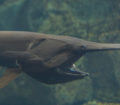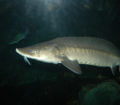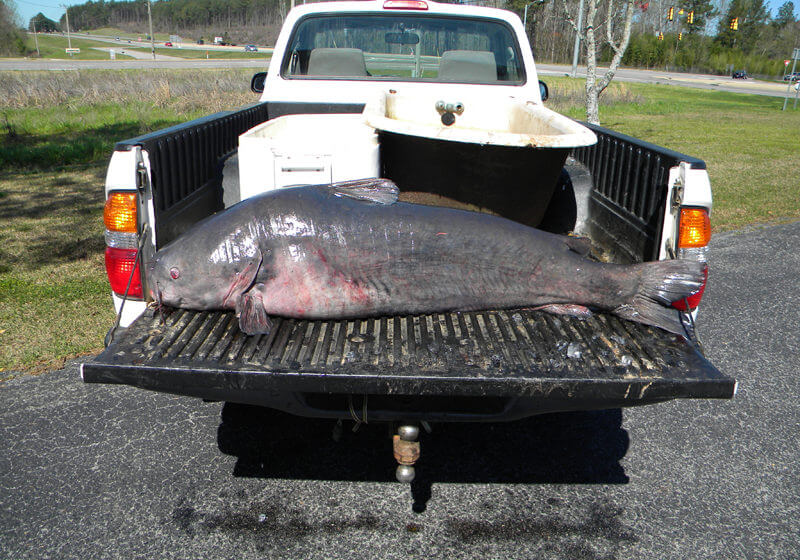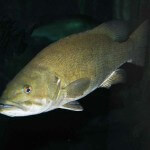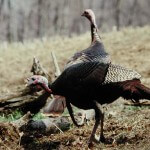John’s Note: When you think of freshwater fish, anything over 10 pounds usually is considered big – very big. But, there are five real giants, topping or approaching the 100-pound mark, that lurk in the depths of America’s freshwater lakes and rivers. Here’s what they are, where they live, and how you can do battle with them.
Although there are more than 1,000 kinds of catfish, there are two types of catfish capable of reaching the monstrous weight of 100 pounds or better – the blue cat and the flathead. Catfish are voracious feeders due to the 100,000 food sensors located all over their bodies. The barbels on the catfish’s face helps it find food as it fans the bottom. Scientists have found that enzyme action in the stomachs of catfish doubles with each 8 degree F increase in temperature. So, the hotter the weather gets, the more catfish feed. And since they prefer dark habitat, they feed mostly at night during hot, sunny weather.
Hovering in the clear, swift streams that have bottoms of bedrock, boulders, gravel or sand, but that can tolerate brackish water, this freshwater monster (Ictalurus furcatus) sometimes grows to over 100 pounds, but the average weight is 50 pounds. In Captain William Heckman’s book, “Steamboating Sixty-Five Years on Missouri’s Rivers,” he mentions a 315-pound blue cat that was taken from the Missouri River just after the Civil War. On June 18, 2011, Nick Anderson of Greenville, NC, reeled in a  143-pound blue catfish from John Kerr Reservoir, more commonly known as Buggs Island Lake, on the Virginia-North Carolina border. On July 20, 2010, a yet-to-be certified new world record blue catfish was caught by Greg Bernal of Florissant, Missouri, on the Missouri River.
143-pound blue catfish from John Kerr Reservoir, more commonly known as Buggs Island Lake, on the Virginia-North Carolina border. On July 20, 2010, a yet-to-be certified new world record blue catfish was caught by Greg Bernal of Florissant, Missouri, on the Missouri River.
A fast grower, the blue catfish is a silvery pale blue above and milk white on its underbelly and is native to the large rivers from Minnesota and Ohio southward, including the whole of the Mississippi Drainage. The blue cat has also been introduced into many Atlantic Coast drainages. Not now as abundant as it was before so many impoundments were built, the blue cat is the largest of the catfish family and likes to eat fish, especially crawfish. It is known for its good sport because of its large size and strong fighting abilities and often feeds heavily in dam tailraces.
The blue cat, considered an excellent food fish, is generally taken by jug fishermen, trotline anglers and tailrace sportsmen who tight-line the bottom. The blue cat will take a variety of baits, including crawfish, shad, worms, mussels, frogs, chicken entrails, beef hearts and almost any type of cut bait. The female blue cat can produce as many as 100,000 eggs at a time.
Flathead Catfish:
This square-tailed catfish (Pylodictis olivaris) with a wide, flattened head with whiskers and a scaleless body is another of the freshwater monsters that sometimes weighs up to 123 pounds. But, the average flathead taken by sportsmen is generally a 3-4 pounder.
Found in the rivers in the Mississippi Valley and the Missouri and Ohio basins from Canada south to the Gulf of Mexico and northeastern Mexico and west to Arizona, the flathead cat (also known as appaloosa cat or Opelousas cat) is brown and mottled with dark brown and likes to lie quietly in shallow water with its large mouth open to catch frightened fish. It particularly likes to rest against big boulders or under submerged logs to hide itself. This fish likes long, deep, sluggish pools of large rivers with hard bottoms.
 Flatheads are usually taken with trotlines, handlines and/or jugging using crawfish and whole or cut fish. Some sportsmen prefer to rod and reel for flatheads, utilizing saltwater, two-handed surf rods about nine feet long, No. 1/0 or 2/0 reels, at least 40-pound test line and heavy, strong hooks like a No. 4/0. Anglers tie the large hook on to heavy leader about two feet long. Then they thread on the line a 4-6-ounce slip-sinker, either a flat or a pyramid shape to keep it from rolling along the bottom in the current, and tie a heavy brass swivel to the end of the line.
Flatheads are usually taken with trotlines, handlines and/or jugging using crawfish and whole or cut fish. Some sportsmen prefer to rod and reel for flatheads, utilizing saltwater, two-handed surf rods about nine feet long, No. 1/0 or 2/0 reels, at least 40-pound test line and heavy, strong hooks like a No. 4/0. Anglers tie the large hook on to heavy leader about two feet long. Then they thread on the line a 4-6-ounce slip-sinker, either a flat or a pyramid shape to keep it from rolling along the bottom in the current, and tie a heavy brass swivel to the end of the line.
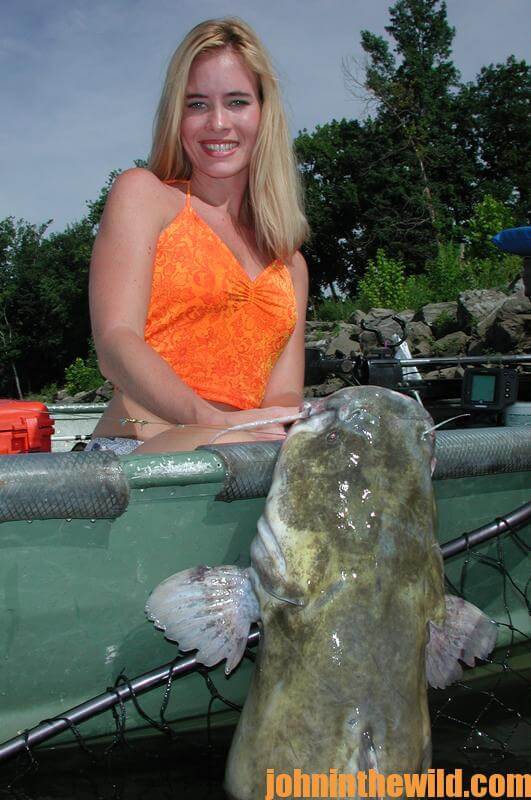 Flatheads are voracious carnivores, feeding primarily on fish, insects, annelid worms and crustaceans. The baits used to take flatheads include cut shad, crawfish, grasshoppers or shrimp. But, many fishermen prefer live bait for the larger flatheads. One-pound carp or eight-inch suckers hooked through both lips are equally effective fishing in a current, while other anglers favor hooking these baits under the back fin in deep, quiet pools. Where legal, the flathead is the most common target of “noodling” or “grabbling,” where the fisherman grabs the fish by hand. A 15- to 30-pound flathead can make this method of fishing quite interesting.
Flatheads are voracious carnivores, feeding primarily on fish, insects, annelid worms and crustaceans. The baits used to take flatheads include cut shad, crawfish, grasshoppers or shrimp. But, many fishermen prefer live bait for the larger flatheads. One-pound carp or eight-inch suckers hooked through both lips are equally effective fishing in a current, while other anglers favor hooking these baits under the back fin in deep, quiet pools. Where legal, the flathead is the most common target of “noodling” or “grabbling,” where the fisherman grabs the fish by hand. A 15- to 30-pound flathead can make this method of fishing quite interesting.
Big flatheads like to spend the day lying on the bottom, but they usually feed at night all over the river. Although the size of flatheads can be enormous, their strike is very gentle, often little more than a slight bobbing of the rod tip, because they take baits slowly and deliberately, mauling and crushing it before swallowing it. They fight deep and make long, powerful circles and have tasty meat. Facebook has many catfish groups, and numerous guides for big catfish can be found on the internet.
To learn more about fishing, you can get John E. Phillips’ eBooks and print books at www.amazon.com/author/johnephillips or at www.barnesandnoble.com.

